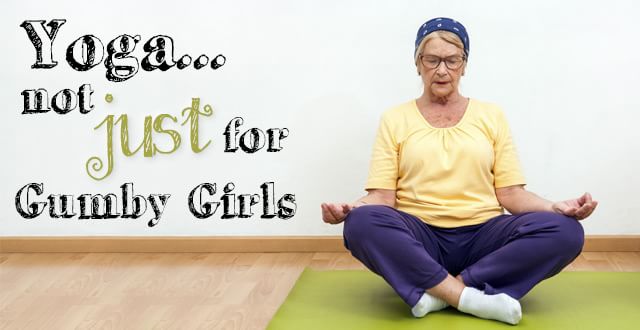One of the pressing issues we face as an aging population is chronic pain. Depending upon one’s age, weight, fitness level, and mindset, most people over age 50 endure some level of daily discomfort in their muscles, bones and joints. Whether it is from a recent injury, surgery, a medical condition, or simply a long history of hard use, nearly all of us have grudgingly given pain a seat in the parlor for the duration. We may have to tolerate this guest, but let’s not serve him tea and crumpets. In other words, it would be ideal if we could find ways to live with, work around, and perhaps even cure musculoskeletal pain with less dependence upon pharmaceuticals. The most logical solution is movement, specifically, yoga. (A collective groan rises up!) Yes, my dears, it is off the couch we go, but maybe not so far as you think.
My partner in life, Gary, is a yoga instructor who completed a notoriously rigorous yoga training with Bikram’s College of India at the age of 57. After 9 weeks of two 90-minute classes a day at 105 degrees, coupled with nauseating sleep deprivation, he graduated feeling like he could walk through fire and whip the world into similar shape. Today, after 6 years of teaching Bikram method and now training faculty internationally, he is surprised and disappointed to learn that craggy, old Pain still comes scratching at the window pane. Having lived a long life and used his body hard in other adventures (a furniture moving business – ouch!), Gary recognizes that he must modify his own yoga practice to accommodate back, hip, knee, and balance issues. He has begun sharing these findings with his student teachers. Benefiting from his age and experience, they are learning to be mindful of the limitations of seniors and those otherwise physically challenged as they lead them through a class. It is easy to teach yoga to limber kids, but more crucial to teach it to the population who needs it most.
As certified members of the Baby Boomer Generation, Gary and I are aware that as we go, so goes the nation. The United States has an outsized aging demographic. We need to have a dialog about the optimum ways to go about getting older with grace. It is not our intention to be health nuts or gym rats. We simply want to move with comfort, hopefully without the aid of pills, canes, or wheelchairs. It is to this end that we are working to spread the word about this ancient and proven practice for mind and body.
One of the first hurdles to overcome is the public perception of yoga. Upon learning that Gary is a yoga instructor, the first thing he always hears is: “I can’t turn into a pretzel like that.” People he meets immediately envision him in a rapturous “Gomukhasana” (cow face pose) and chanting, “ Hare Krishna”. Once disarmed by Gary’s more blue-collar approach to yoga, his partner in conversation is more willing to engage. (“It’s just stretching, Dude!”)
The second biggest misconception is that all yoga classes include new-age music, incense, candles, and praying to Buddha – this being an unpardonable offense to those of different religious persuasions. The general mindset in the yoga community is that hands in Namaskar (prayer position) is a general Indian greeting of respect and certainly not an invocation to pray to any particular god. It is no small coincidence, however, that many who practice yoga are drawn to thinking of the universe and everything in it as all one divine creation. Hardly fighting words, folks. Pray to your very own God when practicing or just think some kind thoughts…s’all good.
Along those lines, yoga practice in the United States offers a virtual smorgasbord to the discerning consumer. What type is best for you? As Bikram was known to say in his broken English: “Pick your choice.” www.webmd.com/balance/guide/which-style-of-yoga-is-best-for-you. If you live in or near a city, virtually all of these types of instruction are available to you. Practicing with others is highly recommended for motivation, friendship, and a good mental game. These classes can be found at yoga studios, community centers, gyms, museums, even churches. If you live outside a city, or if you wish to practice without other eyes on you, there is YouTube for instructional video, also interactive programs such as Wii.
Gary highly recommends Restorative Yoga as a gentle start, even continuing this as a lifetime practice, as long as seniors are stretching to their personal comfort edge, relaxing, moving with purpose and – as an added benefit – gaining peace.
This website offers some introductory poses: www.yogajournal.com/category/poses/types/restorative/.
Yoga is for everyone. In its translation from ancient Sanskrit it means “union”. Once the unfamiliar aspects have been met and rendered harmless, what is left is beautiful, fluid movement, hard effort balanced with restfulness. It is a serious conversation between mind and body, after which one ends up bathed in a serene calmness. Even the dudes will feel it.

